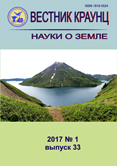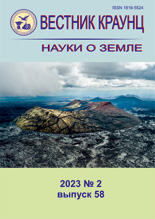Abstract
Halotrichite has been identified in geothermal fields of the Kambalny-Pauzhetka-Koshelev region, the Bolshoi Semiachik complex, and the Mutnovsky volcano (Kamchatka, Russia). Halotrichite forms efflorescence on soils heated up to 70°C, around steam-gas vents and boiling springs. Tschermigite, rozenite, szomolnokite, gypsum, alunogen, barite, melanterite, hexahydrite, and minerals of the copiapite, alunite and voltaite groups were found in close association with halotrichite. The chemical composition of halotrichite samples from different geothermal fields is similar and characterized by Mg substitution in the Fe2+ position, with Fe2+:Mg ratio ranging from 90:10 to 50:50, and also by Fe3+ substitution in the Al position in some samples, with Al:Fe3+ reaching up to 85:15. Halotrichite is a typical mineral of low-temperature volcanic setting, formed as a result of alteration of parent minerals by hydrothermal fluid and represents an intermediate form of crystallization of leached elements. At the same time, the local conditions of mineral formation — such as variations in Eh, pH, surface temperature, and elemental composition — do not reflect in the chemical composition or other thin typomorphic features of halotrichite. The mechanism of halotrichite formation is probably identical in both geothermal fields and zones of oxidation of sulfide deposits.
References
Бритвин С.Н., Доливо-Добровольский Д.В., Кржижановская М.Г. Программный пакет для обработки рентгеновских порошковых данных, полученных с цилиндрического детектора дифрактометра Rigaku RAXIS Rapid II // Записки Российского Минералогического Общества. 2017. Т. 146. № 3. С. 104–107 [Britvin S.N., Dolivo-Dobrovolsky D.V., Krzhizhanovskaya M.G. Software for processing of X-ray powder diffraction data obtained from the curved image plate detector of Rigaku RAXIS Rapid II diffractometer. Zapiski Rossiiskogo Mineralogicheskogo Obshchetstva. 2017. V. 146. № 3. P. 104–107 (in Russian)].
Васильчикова Т.М., Волкова О.С., Раганян Г.В. и др. Статические и резонансные магнитные свойства галотрихита // Челябинский физико-математический журнал. 2022. Т. 7. № 2. С. 254–262 [Vasilchikova T.M., Volkova O.S., Raganyan G.V. et al. Static and resonant magnetic properties of halotrichite // Chelyabinsk physical and mathematical journal. 2022. V. 7. № 2. P. 254–262 (in Russian)].
Действующие вулканы Камчатки. В 2 т. Т. 2 / Под ред. Федотова С.А., Масуренкова Ю.П. М.: «Наука», 1991. 415 с. [Active Volcanoes of Kamchatka / Ed. Fedotov S.A., Masurenkov Yu.P. Moscow: Nauka, 1991. 415 p (in Russian)].
Житова Е.С., Сергеева А.В., Нуждаев А.А. и др. Чермигит термальных полей Южной Камчатки: высокотемпературное преобразование и особенности ИК спектра // Записки Российского Минералогического Общества. 2019. Т. 148. № 1. С. 100–116 [Zhitova E.S., Sergeeva A.V., Nuzhdaev A.A. et al. Tschermigite from thermal fields of southern Kamchatka: high-temperature transformation and peculiarities of IR-spectrum // Zapiski Rossiyskogo Mineralogicheskogo Obshchestva. 2019. V. 148. № 1. P. 100–116 (in Russian)].
Серафимова Е.К., Карпов Г.А. Аммониевые квасцы (чермигит) в выцветах термальных полей вулкана Бурлящий (Камчатка) // Вулканология и сейсмология. 1989. № 5. С. 100–103 [Serafimova E.K., Karpov G.A. Ammonium alum (chermigite) in the efflorescence of thermal fields of Burlyashchiy volcano (Kamchatka) // Volcanology and seismology. 1989. № 5. P. 100–103 (in Russian)].
Adams P.M., Lynch D.K., Buckland K.N. et al. Sulfate mineralogy of fumaroles in the Salton Sea Geothermal Field, Imperial County, California // Journal of Volcanology and Geothermal Research. 2017. V. 347. P. 15–43. https://doi.org/10.1016/j.jvolgeores.2017.08.010
Bortnikova S.B., Bessonova E.P., Zelenskii M.E. Hydrogeochemistry of thermal springs at Ebeco volcano (Kuril Islands) // Proceedings. World Geothermal Congress. Antalia. 2005. P. 1–5.
Ciesielczuk J., Żaba J., Bzowska G. et al. Sulphate efflorescences at the geyser near Pinchollo, southern Peru // Journal of South American Earth Sciences. 2013. V. 42. P. 186–193. https://doi.org/10.1016/j.jsames.2012.06.016
Cody A.D., Grammer T.R. Magnesian halotrichite from White Island, New Zealand // Journal of Geology and Geophysics. 1979. V. 22. № 4. P. 495–498. https://doi.org/10.1080/00288306.1979.10424158
Cotterell T. A review of halotrichite group minerals in Wales // UK Journal of Mines and Minerals. 2009. № 30. P. 43–47.
Eremin O.V., Epova E.S., Yurgenson G.A., Smirnova O.K. Prognosis of Geoecological Consequences of Development of Deposits of the Bom-Gorkhon Tungsten Deposit (Transbaikalia) // Chemistry for Sustainable Development. 2014. V. 22 № 2. P. 123–129.
Gandolfi G. Metodo per ottenere uno «spettro di polveri» da un cristallo singolo di piccole dimensioni (fino a 30μ) // Mineralogica et Petrographica Acta. 1964. V. 10. P. 149–156.
Gongalsky B., Krivolutskaya N. The Cu-Ag-Fe Udokan Deposit // World-Class Mineral Deposits of Northeastern Transbaikalia, Siberia, Russia / Ed. Gongalsky B., Krivolutskaya N. Cham: Springer, 2019. P. 37–85. https://doi.org/10.1007/978-3-030-03559-4
McCollom T.M., Hynek B.M., Rogers K. et al. Chemical and mineralogical trends during acid-sulfate alteration of pyroclastic basalt at Cerro Negro volcano and implications for early Mars // Journal of Geophysical Research: Planets. 2013. V. 118. № 9. P. 1719–1751. https://doi.org/10.1002/jgre.20114
McHenry L.J., Carson G.L., Dixon D.T., Vickery C.L. Secondary minerals associated with Lassen fumaroles and hot springs: Implications for Martian hydrothermal deposits // American Mineralogist. 2017. V. 102. № 7. P. 1418–1434. https://doi.org/10.2138/am-2017-5839
Mueller E. The Debye–Scherrer technique–rapid detection for applications // Open Physics. 2022. V. 20(1). P. 888–890.
Okrugin V.M., Zelensky M.E. Miocene-to-Quaternary center of volcanic, hydrothermal and ore-forming activity in the Southern Kamchatka // Metallogeny of the Pacific Northwest (Russian Far East): Tectonics, Magmatism and Metallogeny of Active Continental Margins. IAGOD Guidebook series 11 / Ed. Khanchuk A.I., Govenchuk G.A., Seltman R. Vladivostok: Dalnauka, 2004. P. 147–176.
Rigaku. PDXL: Integrated X-Ray Powder Diffraction Software, Version 2.8.4.0 (October 23, 2018). Tokyo, Japan, 2018.
Rodríguez A., van Bergen M.J. Superficial alteration mineralogy in active volcanic systems: An example of Poás Volcano, Costa Rica // Journal of Volcanology and Geothermal Research. 2017. V. 346. P. 54–80. https://doi.org/10.1016/j.jvolgeores.2017.04.006
Rodríguez A., van Bergen M.J. Volcanic hydrothermal systems as potential analogues of Martian sulphate-rich terrains // Netherlands Journal of Geosciences. 2016. V. 99. № 2. P. 153–169. https://doi.org/10.1017/njg.2015.12
Ulloa A., Gázquez F., Sanz-Arranz A. et al. Extremely high diversity of sulfate minerals in caves of the Irazú Volcano (Costa Rica) related to crater lake and fumarolic activity // International Journal of Speleology. 2018. V. 47. P. 229–246. https://doi.org/10.5038/1827-806X.47.2.2198
Warr L.N. IMA–CNMNC approved mineral symbols // Mineralogical Magazine. 2021. Vol. 85. № 3. P. 291−320. https://doi.org/10.1180/mgm.2021.43
Wiese Jr R.G., Powell M.A., Fyfe W.S. Spontaneous formation of hydrated iron sulfates on laboratory samples of pyrite-and marcasite-bearing coals // Chemical Geology. 1987. V. 63. № 1–2. P. 29–38. https://doi.org/10.1016/0009-2541(87)90071-4
Zhitova E.S., Khanin D.A., Nuzhdaev A.A. et al. Efflorescent sulphates with M+ and M2+ cations from fumarole and active geothermal fields of Mutnovsky volcano (Kamchatka, Russia) // Minerals. 2022. V. 12. № 5. 18 p. https://doi.org/10.3390/min12050600
Zhitova Е.S., Sheveleva R.M., Zolotarev A.A. et al. The crystal structure of magnesian halotrichite, (Fe,Mg)Al2(SO4)4×22H2O: hydrogen bonding, geometrical parameters and structural complexity // Journal of Geosciences. 2023. https://doi.org/10.3390/jgeosci.XXX
Zhitova E.S., Siidra O.I., Belakovsky D.I. et al. Ammoniovoltaite, (NH4)2Fe2+5Fe3+3Al(SO4)12(H2O)18, a new mineral from the Severo-Kambalny geothermal field, Kamchatka, Russia // Mineralogical Magazine. 2018. V. 82. № 5. P. 1057–1077. https://doi.org/10.1180/minmag.2017.081.083

This work is licensed under a Creative Commons Attribution-NonCommercial 4.0 International License.
Copyright (c) 2023 Р.М. Шевелева, М.А. Назарова, А.А. Нуждаев, П.С. Жегунов, Е.С. Житова

